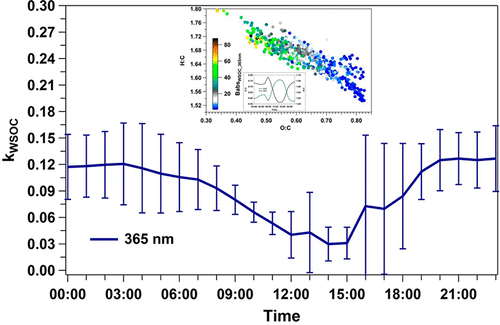当前位置:
X-MOL 学术
›
ACS Earth Space Chem.
›
论文详情
Our official English website, www.x-mol.net, welcomes your
feedback! (Note: you will need to create a separate account there.)
Absorbing Refractive Index and Direct Radiative Forcing of Atmospheric Brown Carbon over Gangetic Plain
ACS Earth and Space Chemistry ( IF 2.9 ) Pub Date : 2017-12-12 00:00:00 , DOI: 10.1021/acsearthspacechem.7b00074 P. M. Shamjad , R. V. Satish 1 , Navaneeth M. Thamban , N. Rastogi 1 , S. N. Tripathi
ACS Earth and Space Chemistry ( IF 2.9 ) Pub Date : 2017-12-12 00:00:00 , DOI: 10.1021/acsearthspacechem.7b00074 P. M. Shamjad , R. V. Satish 1 , Navaneeth M. Thamban , N. Rastogi 1 , S. N. Tripathi
Affiliation

|
Atmospheric carbonaceous aerosols consisting of black carbon and organic carbon influence Earth’s radiative balance by interacting with solar radiation. A subset of organic aerosols known as brown carbon is absorbing in nature and poorly characterized in terms of optical properties. Brown carbon can warm the local and regional atmosphere depending upon its absorbing capacity, mixing state, and meteorological conditions. We report a diurnal spectral absorbing refractive index of brown carbon over North India and its influence on regional radiative forcing. Measurements show the presence of highly absorbing brown carbon consisting of soluble and non-soluble fractions having distinct spectral absorption. The brown carbon refractive index at 365 nm shows a 50% reduction during daytime when compared to nighttime as a result of combined effects of reduced primary emissions and photobleaching/volatilization. Brown carbon and the lensing effect as a result of a thin absorbing coating exert a forcing of −0.93 ± 0.27 and 0.13 ± 0.06 W m–2, respectively, at the top of atmosphere. Externally mixed absorbing organic carbon in radiative forcing calculations produces 48% less cooling when compared to the forcing induced by scattering organic carbon. The presence of internally mixed absorbing organic carbon as a shell over black carbon induces 31% more warming compared to a similar shell made of scattering organic carbon. Overall results suggest that brown carbon and the lensing effect need to be included in global climate models while calculating radiative forcing parameters.
中文翻译:

恒河平原大气褐碳的吸收折射率和直接辐射强迫
由黑碳和有机碳组成的大气碳质气溶胶通过与太阳辐射相互作用来影响地球的辐射平衡。有机气溶胶的一个子集,称为棕碳,在自然界中是吸收性的,并且在光学性质方面的表征很差。褐碳可根据其吸收能力,混合状态和气象条件使局部和区域性大气变暖。我们报告了印度北部地区褐碳的每日光谱吸收折射率及其对区域辐射强迫的影响。测量表明存在由具有明显光谱吸收的可溶和不溶级分组成的高吸收棕色碳。由于减少了一次排放和光漂白/挥发的综合作用,与夜间相比,白天的365 nm棕色碳折射率降低了50%。褐色碳和吸收层薄造成的透镜效应产生-0.93±0.27和0.13±0.06 W m的强迫–2分别位于大气层的顶部。与散布有机碳引起的强迫相比,在辐射强迫计算中外部混合吸收有机碳产生的冷却少48%。与由散布有机碳制成的类似外壳相比,内部混合吸收有机碳作为外壳的情况要多于黑碳,它的变暖现象高出31%。总体结果表明,在计算辐射强迫参数时,棕色碳及其透镜效应需要纳入全球气候模型中。
更新日期:2017-12-12
中文翻译:

恒河平原大气褐碳的吸收折射率和直接辐射强迫
由黑碳和有机碳组成的大气碳质气溶胶通过与太阳辐射相互作用来影响地球的辐射平衡。有机气溶胶的一个子集,称为棕碳,在自然界中是吸收性的,并且在光学性质方面的表征很差。褐碳可根据其吸收能力,混合状态和气象条件使局部和区域性大气变暖。我们报告了印度北部地区褐碳的每日光谱吸收折射率及其对区域辐射强迫的影响。测量表明存在由具有明显光谱吸收的可溶和不溶级分组成的高吸收棕色碳。由于减少了一次排放和光漂白/挥发的综合作用,与夜间相比,白天的365 nm棕色碳折射率降低了50%。褐色碳和吸收层薄造成的透镜效应产生-0.93±0.27和0.13±0.06 W m的强迫–2分别位于大气层的顶部。与散布有机碳引起的强迫相比,在辐射强迫计算中外部混合吸收有机碳产生的冷却少48%。与由散布有机碳制成的类似外壳相比,内部混合吸收有机碳作为外壳的情况要多于黑碳,它的变暖现象高出31%。总体结果表明,在计算辐射强迫参数时,棕色碳及其透镜效应需要纳入全球气候模型中。











































 京公网安备 11010802027423号
京公网安备 11010802027423号